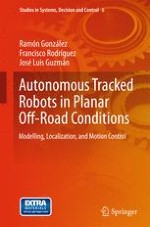This monograph is framed within the context of off-road mobile robotics. In particular, it discusses issues related to modelling, localization, and motion control of tracked mobile robots working in planar slippery conditions. Tracked locomotion constitutes a well-known solution for mobile platforms operating over diverse challenging terrains, for that reason, tracked robotics constitutes an important research field with many applications (e.g. agriculture, mining, search and rescue operations, military activities). The specific topics of this monograph are: historical perspective of tracked vehicles and tracked robots; trajectory-tracking model taking into account slip effect; visual-odometry-based localization strategies; and advanced slip-compensation motion controllers ensuring efficient real-time execution. Physical experiments with a real tracked robot are presented showing the better performance of the suggested novel approaches to known techniques.
Keywords: longitudinal slip, visual odometry, slip-compensation control, robust predictive control, trajectory tracking.
Related subjects: Robotics – Mechanical Engineering – Mechanics – Computer Science – Artificial Intelligence - Applications
